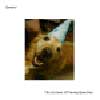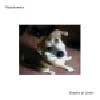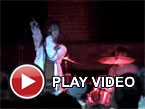Two new shows just for you. We have squeezed out two extended release episodes for this weekend to get you through this week. They contain mostly new songs but there's also new issues from the vaults. The first show features music from Rider/Horse, Mint Field, Robert Aiki Aubrey Lowe, Anastasia Coope, ISAN, Stone Music, La Securite, Bark Psychosis, Jon Rose, Master Wilburn Burchette, Umberto, Wand, Tim Koh, Sun An, and Memory Drawings. The second episode has music by Laibach, Melt-Banana, Chuck Johnson, X, K. Yoshimatsu, Dorothy Carter, Pavel Milyakov, Violence Gratuite, Mark Templeton, Dummy, Endon, body / negative, Midwife, Alberto Boccardi, Divine. Cow in Maui from Veronika in Vienna. Get involved: subscribe, review, rate, share with your friends, send images! |
A warm, honest record from the deep south.
Piehead
 Standing as a fill-in for the unfortunately absent Edward Ka-Spel asPiehead's 11th release this year, Qwerty more than manages to keep theseries interesting as it draws to a close. Qwerty is a solo Croatianelectronic artist who is working in the well-traveled but stillenjoyable paths cut by Warp Records trailblazers and theircontemporaries nearly a decade ago.
Standing as a fill-in for the unfortunately absent Edward Ka-Spel asPiehead's 11th release this year, Qwerty more than manages to keep theseries interesting as it draws to a close. Qwerty is a solo Croatianelectronic artist who is working in the well-traveled but stillenjoyable paths cut by Warp Records trailblazers and theircontemporaries nearly a decade ago.
 Standing as a fill-in for the unfortunately absent Edward Ka-Spel asPiehead's 11th release this year, Qwerty more than manages to keep theseries interesting as it draws to a close. Qwerty is a solo Croatianelectronic artist who is working in the well-traveled but stillenjoyable paths cut by Warp Records trailblazers and theircontemporaries nearly a decade ago.
Standing as a fill-in for the unfortunately absent Edward Ka-Spel asPiehead's 11th release this year, Qwerty more than manages to keep theseries interesting as it draws to a close. Qwerty is a solo Croatianelectronic artist who is working in the well-traveled but stillenjoyable paths cut by Warp Records trailblazers and theircontemporaries nearly a decade ago.
Piehead
 With Piehead's 10th installment this year, the label offers up apleasant slice of lo-fi electro in the form of the Nippon-o-centricalbum from Robokoneko (or Robot Cat for the gaijin.) The record beginswith a sample from 2010wherein the professor and the machine are wondering if computers dream.From that simple sample, the rest of the agenda for Robokoneko is laidout.
With Piehead's 10th installment this year, the label offers up apleasant slice of lo-fi electro in the form of the Nippon-o-centricalbum from Robokoneko (or Robot Cat for the gaijin.) The record beginswith a sample from 2010wherein the professor and the machine are wondering if computers dream.From that simple sample, the rest of the agenda for Robokoneko is laidout.
 With Piehead's 10th installment this year, the label offers up apleasant slice of lo-fi electro in the form of the Nippon-o-centricalbum from Robokoneko (or Robot Cat for the gaijin.) The record beginswith a sample from 2010wherein the professor and the machine are wondering if computers dream.From that simple sample, the rest of the agenda for Robokoneko is laidout.
With Piehead's 10th installment this year, the label offers up apleasant slice of lo-fi electro in the form of the Nippon-o-centricalbum from Robokoneko (or Robot Cat for the gaijin.) The record beginswith a sample from 2010wherein the professor and the machine are wondering if computers dream.From that simple sample, the rest of the agenda for Robokoneko is laidout.
ICR
 I have to wonder what the trio of Darren Tate, Colin Potter, and PaulBradley has in mind when they record a set such as this one. Perhapsthey have in mind the construction of psychic hammer dedicated to theeradication of the sensual world or perhaps they simply mean to open upa space where it seems that no such space could possibly fit or exist. Landscapes has the strange quality of being both musical and completely self-indulgent.
I have to wonder what the trio of Darren Tate, Colin Potter, and PaulBradley has in mind when they record a set such as this one. Perhapsthey have in mind the construction of psychic hammer dedicated to theeradication of the sensual world or perhaps they simply mean to open upa space where it seems that no such space could possibly fit or exist. Landscapes has the strange quality of being both musical and completely self-indulgent.
 I have to wonder what the trio of Darren Tate, Colin Potter, and PaulBradley has in mind when they record a set such as this one. Perhapsthey have in mind the construction of psychic hammer dedicated to theeradication of the sensual world or perhaps they simply mean to open upa space where it seems that no such space could possibly fit or exist. Landscapes has the strange quality of being both musical and completely self-indulgent.
I have to wonder what the trio of Darren Tate, Colin Potter, and PaulBradley has in mind when they record a set such as this one. Perhapsthey have in mind the construction of psychic hammer dedicated to theeradication of the sensual world or perhaps they simply mean to open upa space where it seems that no such space could possibly fit or exist. Landscapes has the strange quality of being both musical and completely self-indulgent.
Mute
Suicide changed my life. This summer, New York City was treated to anexclusive one-off concert of the legendary duo of instrumentalistMartin Rev and vocalist Alan Vega at the Knitting Factory. Drenchedfrom the downpour outside, I shivered with my beer until they arrivedon stage and proceeded to show this jaded critic just how powerful aseemingly simple two man performance can be. Ripping through a set ofclassics ("Ghost Rider," "Cheree") and more recent material ("DeathMachine," "Misery Train," the unreleased "Friday Night Fever"), Suicideenergized the entire audience again and again, ultimately leaving touproarious hollers and applause. Immediately afterwards and still, Iconsidered this night to be one of the greatest musical experiences inrecent years, rivalling several notable shows including the return ofPsychic TV.
Suicide changed my life. This summer, New York City was treated to anexclusive one-off concert of the legendary duo of instrumentalistMartin Rev and vocalist Alan Vega at the Knitting Factory. Drenchedfrom the downpour outside, I shivered with my beer until they arrivedon stage and proceeded to show this jaded critic just how powerful aseemingly simple two man performance can be. Ripping through a set ofclassics ("Ghost Rider," "Cheree") and more recent material ("DeathMachine," "Misery Train," the unreleased "Friday Night Fever"), Suicideenergized the entire audience again and again, ultimately leaving touproarious hollers and applause. Immediately afterwards and still, Iconsidered this night to be one of the greatest musical experiences inrecent years, rivalling several notable shows including the return ofPsychic TV.
Mute/Spoon
In many ways, Can was (and is) the ultimate rock band. Accordingly,volumes have been written about Can by writers far more eloquent,knowledgeable and pretentious than me, so I will forgo any in-depthexplication of the band's considerable importance and influence.Suffice to say that Can virtually invented a new paradigm for rockmusic, pioneering a marriage of avant-garde techniques andimprovisational rock. They combined classically trained instrumentalvirtuosity with unhinged psychedelic meltdown, and recorded epicrecords filled with massive, funky grooves that were simultaneouslytrance-inducing and booty-shaking.
In many ways, Can was (and is) the ultimate rock band. Accordingly,volumes have been written about Can by writers far more eloquent,knowledgeable and pretentious than me, so I will forgo any in-depthexplication of the band's considerable importance and influence.Suffice to say that Can virtually invented a new paradigm for rockmusic, pioneering a marriage of avant-garde techniques andimprovisational rock. They combined classically trained instrumentalvirtuosity with unhinged psychedelic meltdown, and recorded epicrecords filled with massive, funky grooves that were simultaneouslytrance-inducing and booty-shaking.
Kranky
 Greg Davis has illuminated the link between sound and light. Perhaps,when the universe was first unfolding, the explosions sounded like buzzsaws or pure white noise, but when the heavens came to be and from itsconvulsions the universe produced stars and angels, the sound generatedmust've been close to the music on Somnia.
Greg Davis has illuminated the link between sound and light. Perhaps,when the universe was first unfolding, the explosions sounded like buzzsaws or pure white noise, but when the heavens came to be and from itsconvulsions the universe produced stars and angels, the sound generatedmust've been close to the music on Somnia.
 Greg Davis has illuminated the link between sound and light. Perhaps,when the universe was first unfolding, the explosions sounded like buzzsaws or pure white noise, but when the heavens came to be and from itsconvulsions the universe produced stars and angels, the sound generatedmust've been close to the music on Somnia.
Greg Davis has illuminated the link between sound and light. Perhaps,when the universe was first unfolding, the explosions sounded like buzzsaws or pure white noise, but when the heavens came to be and from itsconvulsions the universe produced stars and angels, the sound generatedmust've been close to the music on Somnia.
Beta-lactam Ring
 It is unfortunate for Matt Waldron (Irr.App.[Ext.]) that his reworking of the Angry Eelectric Finger raw material was alotted Volume Three status, as he has used many of the same sounds as Jim O'Rourke used in his Volume One. Although both albums are excellent listens, perhaps owing to the strength of the source material, both artists have done little alteration and their volumes sound a bit too similar at times.
It is unfortunate for Matt Waldron (Irr.App.[Ext.]) that his reworking of the Angry Eelectric Finger raw material was alotted Volume Three status, as he has used many of the same sounds as Jim O'Rourke used in his Volume One. Although both albums are excellent listens, perhaps owing to the strength of the source material, both artists have done little alteration and their volumes sound a bit too similar at times.
 It is unfortunate for Matt Waldron (Irr.App.[Ext.]) that his reworking of the Angry Eelectric Finger raw material was alotted Volume Three status, as he has used many of the same sounds as Jim O'Rourke used in his Volume One. Although both albums are excellent listens, perhaps owing to the strength of the source material, both artists have done little alteration and their volumes sound a bit too similar at times.
It is unfortunate for Matt Waldron (Irr.App.[Ext.]) that his reworking of the Angry Eelectric Finger raw material was alotted Volume Three status, as he has used many of the same sounds as Jim O'Rourke used in his Volume One. Although both albums are excellent listens, perhaps owing to the strength of the source material, both artists have done little alteration and their volumes sound a bit too similar at times.



